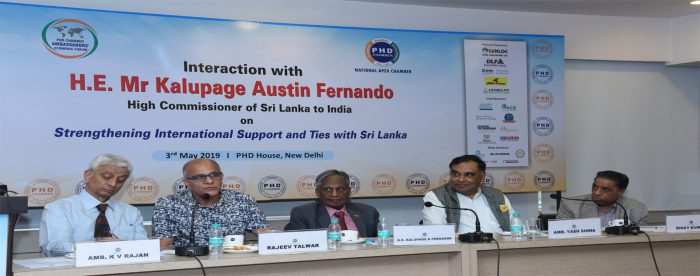
To many in the north east even a hint that the Easter terrorist outrage in Srilanka and her development experience might hold some lessons for the region would appear far fetched as the situations seem so very different and Srilanka so far away. North East is land locked and struggling to build social and physical infrastructure for economic development while addressing ethnic unrest across the region.
Srilanka,on the contrary is an emerging diversified economy with a steady growth and a per capita gross national income of US$ 4265 holding 71st position in the UN Human Development index -the highest in South Asia. Her location in the center of the Sea routes connecting west Asia and the Indo Pacific accords her an enormous strategic importance.
However a perception emerged in a consultation with Austin Fernando Sri Lankan Ambassador organised by the Ambassadors Economic forum of the PHDCC at New Delhi on May 3 under guidance of the Forum’s convenor KV Rajan, distinguished diplomat and a former Indian Ambassador to Nepal that developments in the post 21st April Easter outrage in Sri Lanka that left 258 dead and over 500 maimed in the terrorist attacks on 3 churches and 4 luxury hotels hold important lessons and provide opportunities for broadening India Sri Lanka cooperation in security and diverse development activities .
The PHDCC forum is unique because of its stand that industry and business development must be seen as a part of the regional geopolitics and not in isolation because then only private sector initiatives in the neighbourhood could yield tangible and sustainable results.
From this broad perspective, north east and Assam in particular and Sri Lanka appear to have much in common; first, a tenuous land link- the Siliguri corridor with the rest of India and Sri Lanka, though an island is separated from Peninsular India by an equally narrow patch of Sea ;and second, diverse ethnicity and presence of ‘ geopolitical minorities’, that is , ethno lingual religious groups dominating some regions even when they are’ minorities’ in the population as a whole as the Tamils in the north and east of Sri Lanka and Bengalis in the Barak valley districts in Assam. Third , both Sri Lanka and Assam experienced massive demographic changes caused by migration of labour from the neighbourhood following introduction of tea and jute in Assam and Tea, coffee and spices in Sri Lanka and other forms of ” extractive” activities by the colonial state. The presence of Tamils in the plantations added to the Sinhalese- Tamil divide after Sri Lanka attained independence in 1948 as the Sinhalese viewed them as ” Indian Tamils and “illegal migrants” – much like the way the ” Bangladeshi” is seen in the North East. Thus the citizenship of “migrant Tamils” was a thorny issue of Indo Sri Lankan relationship right from 1948 :and India agreed to the repatriation of such Tamils in phases .In both Assam and Srilanka ” official language policy” triggered the divide ; and led to Tamil militancy and demand for ” Tamil Eelam”- an independent Tamil homeland in Srilanka, a hard fought 26 year long civil war and yet unresolved issues of autonomy of Tamil regions even when about 8 lakhs of Tamils left Srilanka for India and other countries. In the North East ” tribal identity movements” which got a huge boost by the language policy of Assam led to reorganization of the north east region in 1971and and eventually into seven states though statehood demands of several Assam tribes like the Bodos are still unmet.
Finally, both Srilanka and North East- especially Assam have large Muslim population with cultural and linguistic links with Muslims of South India and Bangladesh respectively. In Assam transfer of Goalpara, Sylhet and Cachar-three populous Bengal districts to Assam when the province was carved out of Bengal Presidency in 1874, and introduction of jute cultivation in lower Assam explain the current demography.
In Srilanka though the Muslims form only 9% and not a ” geopolitical minority group” , Sinhalese 70% , Tamils 13% and the Christians 7.4% of Srilankan population the Muslims have significant presence in trade and industry.
In this backdrop, the Easter outrage for which the global terror group ISIL- Islamic state of Iraq and Levant claimed responsibility produced a” shock and awe” effect in Srilanka given the fact that the Muslims- mostly Tamils didn’t identify themselves with the cause for Tamil homeland-Eelam and the armed struggle that the LTTE- Liberation Tigers of Tamil Eelam launched in 1983 and ended in its defeat in May 2009. Next, the evidence that a home grown outfit- National Thowhith Jamath committed the terror outrage at three churches and 4 luxury hotels and that the radicalized Muslim youth of wealthy families were involved contrary to the conventional view that the poor among the Muslims are susceptible to such influences hardened the resolve of the Srilankan state to eradicate the menace.
From this perspective Assam is placed in a more difficult situation as it has porous land border with Bangladesh- an Islamic Republic and a Delta which is hard to divide where radical Islam is getting stronger in the districts adjoining Assam and North East. Recent media reports of growing influence of the banned outfit Hizb ut Tahir in Chittagong Port City, disclosure of its plans for cocktail bombing in Dhaka, dissemination of incrementing materials in the border areas and its possible links with ISIL and Bangladesh based terror groups like Jamaiatul Mujahideen are security concerns for Assam as the contagion could easily spread as it did in Sri Lanka.
Thus to deny these groups any political space in Assam, an early resolution of the citizenship and NRC exercise in a just, fair and transparent manner is a strategic need for stability and progress of Assam and the North East. The recent decision of the centre to assist Assam to set up 1000 Tribunals to deal with the citizenship cases is a step in the right direction.
The Srilankan Ambassador assured that despite the Easter outrage Srilankan economy is robust and invited Indian investment in Srilanka and technological co-operation. There are interesting commonalities in the economies of Assam and the North East and Srilanka and potential for technical cooperation in several areas as for example in Tea which contributes 2% to Srilankan GDP employing about a million people majority of whom are employed in ” small Tea holdings” producing Tea leaves for the tea factories owned by large Tea estates and companies.
To promote Tea plantations in small holdings as a job creation and rural anti poverty program Srilanka had set up a “Tea small holdings Authority” which could be a model for emerging Tea growing states of the region like Sikkim,Arunachal, Nagaland, Mizoram apart from major Tea growing states like Assam, North Bengal and Tripura. Tea plantations in small holdings for production and sale of Tea leaves to factories is already a part of tea development strategy of Assam and the Tea Board. This could be an entry point for Srilanka North East India economic cooperation and in this Tea experimental research station at Jorhat in Assam, the oldest Tea Research center of the world could play a lead role.
Duty free entry of Srilankan Tea to the Indian market as a part of the South Asia Free Trade Association could be another initiative for mutual benefit in terms of meeting growing demand for value added Tea in India and thereby promoting expansion of Srilankan Tea industry.
It may be recalled that Tea plants brought from Assam Tea Planters Association in 1854 were raised in nurseries and transplanted in the first tea garden of Srilanka at Kandy.
The other potential areas of scientific and technological co-operation are in Rice Research, coffee, cinnamon, rubber and spices because developments in the north east in these fields though initiated quite some time back by the national level Commodity Boards have not picked up; and hence experience and technology sharing with Srilanka might be of great help for the region. Similar cooperation in meeting challenges of climate change and natural disaster preparedness is needed for mutual progress; and more so because when put in place it would create durable institutional linkages the kind of which ASEAN have been able to build in areas of higher education and collaborative Research and Development efforts.
Finally cooperation in tourism is a promising area as presently Sri Lankan tourism attention hasn’t reached beyond Calcutta and Bengal; but surely collaboration with the north east might enable Sri Lankan tourism to attract tourists from north east states, Nepal, Bhutan and possibly Bangladesh and Myanmar.
It is time to take bold initiatives in the north east not only to act east but also to look and act South.


















